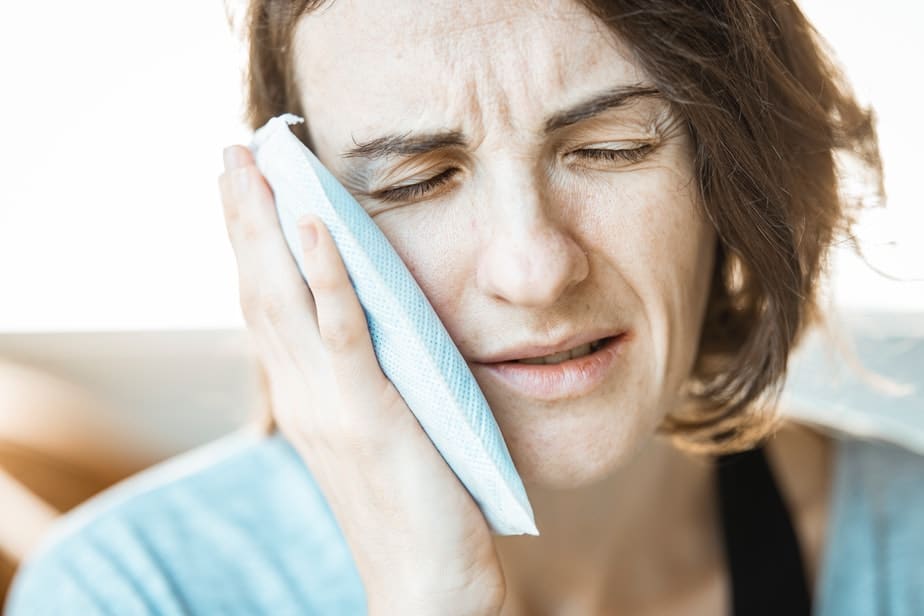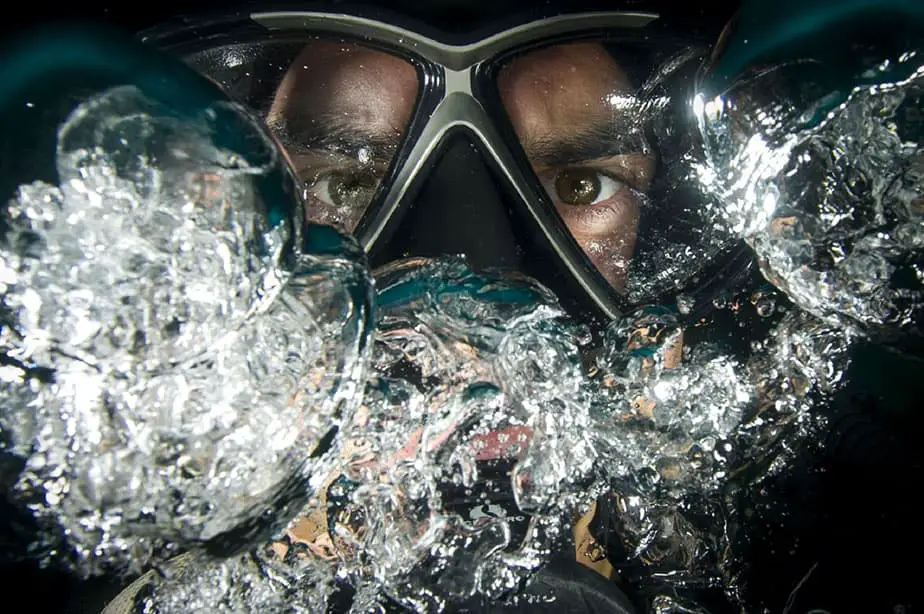When you’re just starting out with scuba diving, all of the skills you need to learn can be overwhelming. One common problem beginners face is mask squeeze. Thankfully, mask squeeze is more embarrassing than it is dangerous, however it is still something you should try to avoid.
Mask squeeze can be avoided by exhaling from your nose every few feet on the descent. This equalizes the pressure inside your dive mask so that it matches the pressure outside. Failing to do so will cause the mask to vacuum tightly on your face, which is painful and can lead to facial barotrauma. You are most likely to experience mask squeeze in the first 10 metres (33 feet) of the dive.
What is Mask Squeeze
Mask squeeze occurs when you do not equalize the air pressure inside the dive mask. This causes the gas inside the mask to compress tightly against your face. The pressure this causes can be so powerful that it can burst the small blood vessels around your eyes. We don’t recommend you search up what that looks like; it’s the stuff of nightmares.
As you can imagine, having a mask squeezing so tightly against your face is uncomfortable. If you do not equalize the pressure quickly enough, you can experience redness and bruising around your face, swelling, nosebleeds, burst blood vessels, and changes in vision in extreme cases. With that said, prevention is straightforward and you would have to be extremely negligent to allow mask squeeze to affect you to such an extreme degree.
Common Causes of Mask Squeeze and Facial Barotrauma
Beginners are prone to experiencing mask squeeze because they aren’t paying attention. One needs to take the necessary steps to avoid the pain and discomfort caused by mask squeeze. The most common causes of mask squeeze are:
Not equalizing the pressure in the mask while descending
All you need to do is occasionally exhale from your nose to equalize the pressure. Since divers also need to do this to equalize their ears, plus the fact that it can get quite painful diving deeper without equalizing, it’s very hard to forget this step.
Yet, sometimes beginners do forget because they are so overwhelmed. Particularly since new divers are often diving around the 10m (33ft) mark, it’s shallow enough that some divers simply don’t notice the increased pressure around their eyes. Then they’ll surface with barotrauma eyes and bruise marks where the mask was pressing against the face.
Poor-fitting mask
If the mask was already tight-fitting to begin with, it’s only going to get tighter while descending. You can tell if a mask fits you well without even entering the water. Test if the mask can stay on your face without the mask strap or support from your fingers. Simply inhale to create a small vacuum, and if it doesn’t fall, then this mask fits your face well.
Masks that fail the above test aren’t designed to fit your facial structure. To compensate, people over-tighten the mask strap so that the mask is squeezing against the face and the straps are digging into their skin. If you need to resort to these methods to get a watertight seal, then the mask is poor-fitting and you should get another one. Any added pressure from lack of equalization will definitely cause facial barotrauma.
Descending too quickly
Sometimes beginners don’t realize just how quickly they are descending. In our article about how divers can go up and down, we mentioned that divers should only be deflating their BCD slowly until they reach a point where simply exhaling causes the diver to descend a little bit. If a diver deflates their BCD too quickly, they will sink rapidly and may not be able to equalize their mask and ears in time. Always adjust your BCD slowly and keep an eye on your dive computer to determine your descent rate.
Tips to Prevent Mask Squeeze
Beginners are the most susceptible to mask squeeze because they may be nervous or overwhelmed by all of the equipment and safety steps they need to keep track of. Since their attention is divided, they don’t even realize mask squeeze is occurring.
Remember to breathe
The less things you need to keep track of, the better. That is why we are fans of committing certain actions to muscle memory. One of the most important rules to make a habit of when scuba diving is to constantly breathe. That means deep inhales and exhales. As long as you exhale from your nose as you descend, you are equalizing the pressure and preventing mask squeeze. Never hold your breath and remember to breathe normally.
Equalize your ears
Oftentimes the pain from mask squeeze is overshadowed by the pain of ear squeeze. You may forget to equalize your mask, but when your eardrums are about to burst, you’re not going to forget to equalize your ears. This is often done using something called the Valsalva maneuver.
Despite the complicated name, you probably already know what the Valsalva maneuver is. It’s when you pinch your nose and then try to forcefully exhale through it. By doing this, it’s quite common for some air to leave through your nose and equalize your mask. If it’s not enough, just make it a habit to exhale through the nose without pinching it after equalizing your ears.
Stay vigilant
You want to be in tip-top condition when diving. Do not dive when you’re tired or if you’ve had alcohol recently. All it takes is a couple of cans of beers in your system to impair you. The scary thing is, you’ll feel fine and you won’t even realize that you’re impaired unless a sober diver tells you.
Divers who are sleep-deprived also exhibit similar symptoms as someone who is inebriated. Their coordination will be off and they’ll make errors in judgment that any sober or well-rested diver wouldn’t. When a diver is impaired, they are observed to make numerous safety violations such as ignoring their no-decompression limits, depth limits, and even air limits.
For this reason, we recommend divers avoid alcohol entirely if they know they will be diving soon. Divers should also get a good night’s rest so that their mind is clear. Then they will also remember to equalize their mask and ears every few feet.
Don’t over-tighten the mask strap
Tightening the mask too much is a common mistake beginners make. They are so worried that water might leak in so they go overboard on tightening the strap. It can also be a sign that the mask is ill-fitting, and the mask strap is compensating for the poor fit. By not over-tightening the mask strap, you can prevent mask squeeze.
It’s natural for some water to enter the mask at some point. That doesn’t mean the mask is ill-fitting. When this does occur, simply tilt your head up, press the top of the mask to open a small pocket on the bottom for the water to escape, and exhale to clear the mask. This step also happens to equalize your mask.
Another reason that the mask strap should not be very tight is that the water pressure will simply keep the mask on your face. You’ll find that once submerged, you technically don’t even need the strap anymore for the mask to remain on your face. So why tighten it so much at the surface?
How serious is mask squeeze?
Mask squeeze looks more serious than it is. It can cause bruises around the eyes, burst blood vessels, and swelling. Thankfully, the damage is almost never serious or permanent. Your eyes will look like they are in terrible shape, however it looks worse than it actually is and should clear up on its own.
In extreme cases, the hemorrhage may take longer to clear up, and you may even experience eye pain or loss of vision. If this happens, you need to go to the doctor immediately. Doctors may prescribe antibiotic drops to prevent an eye infection from occurring.
Mask Squeeze Treatment

Thankfully, the vast majority of mask squeeze injuries heal on their own. If you want, you can use an ice pack wrapped in a plastic bag or place a cold wet towel over the bruised areas to decrease the swelling. You can also take some mild painkillers to help you deal with the pain.
To ensure the healing process goes smoothly, we recommend taking a break from diving for a few days. Not only will it be painful diving with a bruised face, but you don’t want to aggravate the injury any further. Be patient and let your body break down and reabsorb the blood around the bruised areas. You’ll be healed in no time.
Can You Get Mask Squeeze from Snorkeling?
Snorkelers are unlikely to experience mask squeeze since it is dependent on descending, and snorkelers spend most of their time at the surface or in shallow waters. Thus, the pressure differential is never that great to worry about mask squeeze.
With that said, there are rare cases where snorkelers have experienced mask squeeze. Some cases were caused by a mask that was on too tight. A few were caused by snorkelers who went diving. Freedivers can also dive deep enough to where mask squeeze becomes an issue.
As with mask squeeze when scuba diving, prevention and treatment of it is the same. If you surface with bruising and swelling, then stay out of the water for a few days to let it heal. If there is loss of eyesight, seek medical attention.
How deep until mask squeeze becomes a problem?
At sea level, the air pressure is 1 atmosphere (or 1 bar). Every 10 meters (33 feet) of depth, the pressure doubles since water is denser than air. So at 10m the pressure is 2 atmosphere, at 20m it’s 3 atmosphere, and so on.
Mask squeeze can occur even at depths of 10m or less. That’s why it’s possible for snorkelers who also dive to experience mask squeeze. That is why it is crucial for beginner scuba divers to know about the preventative measures to prevent mask squeeze from occurring. They must breathe normally and exhale through their nose to equalize the pressure.
Parting Words
To recap, mask squeeze occurs when the air inside the mask is not equalized to the pressure outside. Since the air compresses as one descends, it causes the mask to squeeze tightly against the face. To equalize, simply exhale through the nose. Failure to do so can cause bruising and burst blood vessels.
This is also the reason why swim goggles can’t be used for scuba diving. Since swim goggles don’t have nose pockets, the air inside the goggles cannot be equalized and it will just squeeze more and more as one descends.
Another common cause of mask squeeze is wearing a mask with overly-tightened straps. The mask should fit snug on your face with barely any support from the straps. An ill-fitting mask that can only be worn with tight mask straps is not ideal. Find a mask that fits your facial structure instead.
Lastly, if you have experienced mask squeeze, take some time off to recover. If your eye is in pain or your vision has been impacted, you should see a doctor immediately. Most mask squeeze injuries are not serious and will heal on their own.


